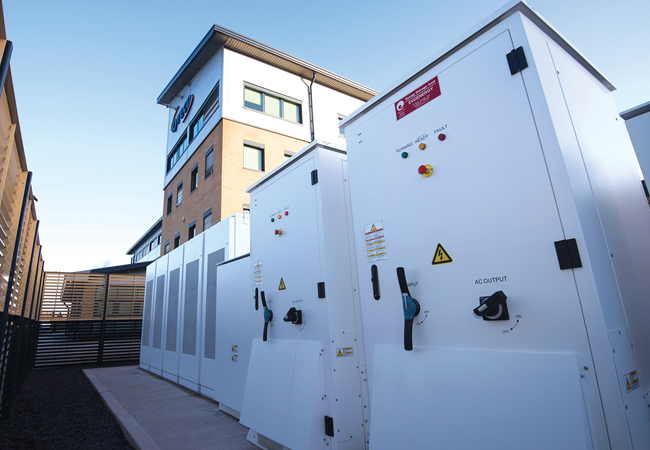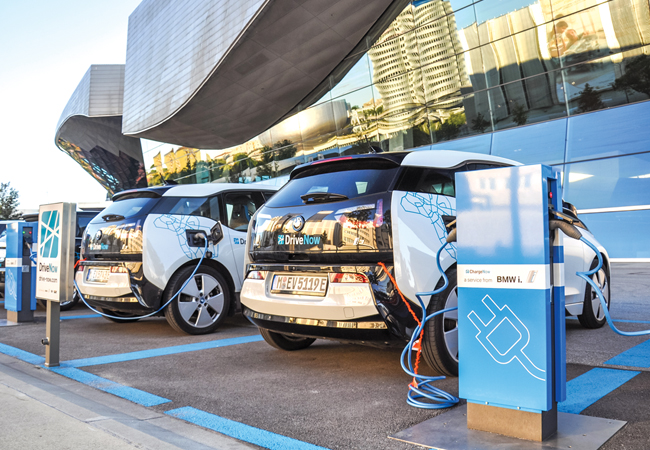
Lark Rise, the focus of this month’s CIBSE Journal case study, demonstrates that the ‘building as a power station’ concept is possible. Equally importantly, Lark Rise – by managing its peak electrical demand – indicates that, if the concept were to be rolled out nationally, an electrical Grid powered by renewable energy is viable.
‘It shows how the smart energy revolution has the potential to enable the UK to be fuelled entirely by renewable energy,’ says the building’s architect, Justin Bere.
A Grid powered by renewables has the potential to turn electricity pricing strategies on their head. Currently, gas, oil and coal power are a significant proportion of the UK’s generating capacity. All these fossil fuels are commodities, traded on financial markets, with the cost of electricity based on the cost and quantity of fuel used in its generation.
Wind and sun, however, are not tradable commodities; they do not cost anything, so users are effectively charged only for the use of the infrastructure, which will change the relationship householders have with their power supplier.
‘The system we had 20 years ago was that demand was what it was, and National Grid turned things on and off to meet demand,’ said John Fox, practice manager, business model innovation, Energy Systems Catapult, at this year’s Futurebuild event. ‘Renewables cannot be switched on and off; for that reason, we have to make demand follow supply and harvest energy when renewables are providing, and try to minimise energy use when that is not the case.’
What this means in practice is that a householder who can be flexible with their electrical demand can have a significant impact on their carbon intensity and, potentially, the price they pay for power.
Without battery storage, any impact is likely to be limited – people may be happy to run their washing machine or dishwasher overnight or during the day, but how many will be prepared to move the time of their evening meal or turn off their television to avoid the evening peak? It is an evening peak that could be made worse by the rapid growth in electric vehicle sales, which could result in large peak-load increases.
“Supply of electricity may depend on whether the sun shines or wind blows, and peak supply will almost certainly not coincide with peak demand.”
Currently, electric cars make up a relatively small proportion of all vehicles sold in the UK, but their numbers are growing rapidly as they become more affordable, battery technology improves and cities introduce clean air initiatives, such as London’s Ultra Low Emissions Zone, which came into force on 8 April. The expectation is that Building Regulations will require all new homes to have an electric vehicle charge point, potentially adding to demand on the Grid.
At the moment on a big housing development, ‘the diversified peak electrical demand averages out at approximately 1.5kW for each house’, says Barny Evans, head of sustainable places, energy and waste at WSP. That means that, if a scheme has 1,000 homes, the peak electrical demand will total 1.5MW.
However, if every property has a 7kW electric vehicle charge point without diversification, each house would require 8.5kW of electrical power – or a whopping 8.5MW for the entire 1,000-home development. ‘There will have to be some form of diversification, otherwise there will be a huge problem,’ Evans warns.
The electrical demand for a home currently peaks at around 6pm or 7pm – and if the majority of electric vehicle owners arrive home from work and plug in their car to charge, the peak electrical demand will increase significantly. ‘When you use energy may start to have more of an impact on your bill than the amount of energy you use,’ says Evans.
It is a problem that, potentially, will be made worse by an electrical Grid increasingly reliant on renewables, notably solar and wind. As a consequence, the supply of electricity may vary depending on whether the sun shines or the wind blows – and, with our current infrastructure, peak supply will almost certainly not coincide with peak demand.
It is also worth considering that when the renewable energy contribution to the Grid is at its peak, the carbon intensity of the Grid will be at its lowest – so shifting demand will have a significant environmental upside.

Greater EV uptake is likely to result in an increase in peak electrical demand. Credit: Sven Loeffler
Domestic battery storage can offer some flexibility in matching the demand profile of a home with the Grid and with onsite generation, as bere:architects successfully demonstrated with Lark Rise. But, currently, domestic-scale batteries are expensive.
One solution to providing battery storage – particularly for new developments with multiple homes – is community battery for energy storage, a concept being trialled at the Trent Basin housing scheme in Nottingham.
The scale of its battery installation enables it to supply or absorb power from the National Grid under a frequency-response-type contract, which –in the case of Trent Basin – is, potentially, a significant revenue driver, and a means of helping to offset the cost of the battery system. (See article ‘Battery packs a punch’ in January 2018 CIBSE Journal).
The growth of electric vehicles could, however, mean they are part of the solution rather than being part of the problem. There could be 1TWh of electric storage in vehicle batteries by 2035, says Evans, who believes it would be ‘a game changer’ – particularly when 100GWh of battery storage will allow the whole of the UK to be powered off-Grid for a couple of hours. (See panel, ‘Mobile batteries’)
Lark Rise – this year’s CIBSE Building Performance Awards Residential Project of the Year – is, perhaps, a foretaste of how all new homes might be designed to work with a Grid powered by renewable energy. It shows that, with creative design, it is possible to mitigate demand on the UK electrical infrastructure – and after Chancellor Philip Hammond’s announcement, in his Spring Statement, that gas heating is to be banned in new houses from 2025, it might prove to be a benchmark for all new homes.






